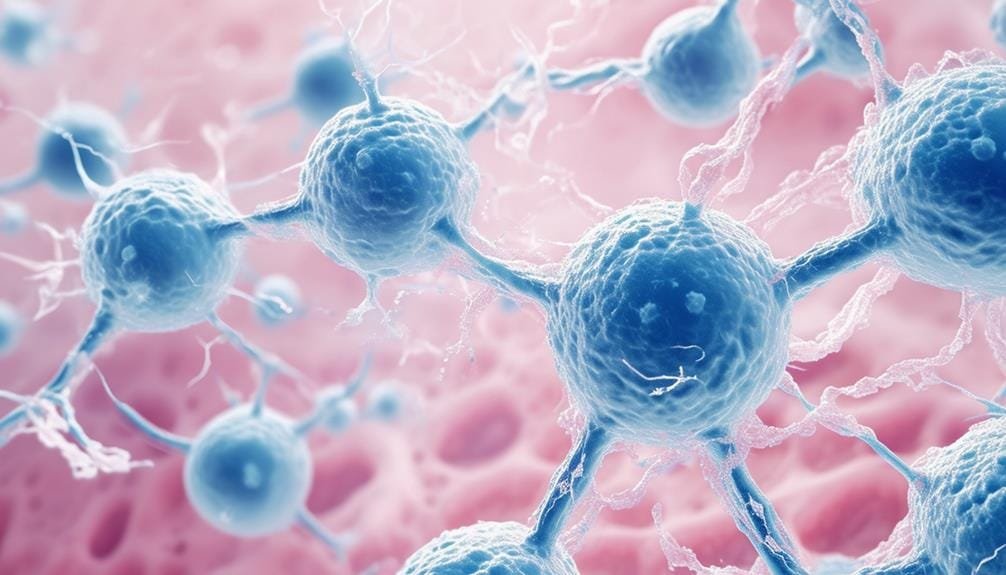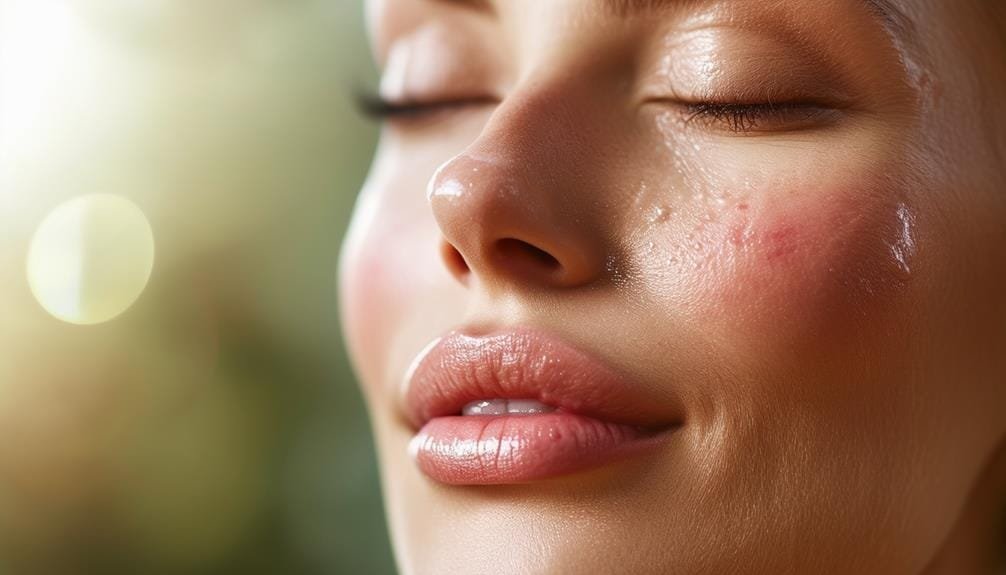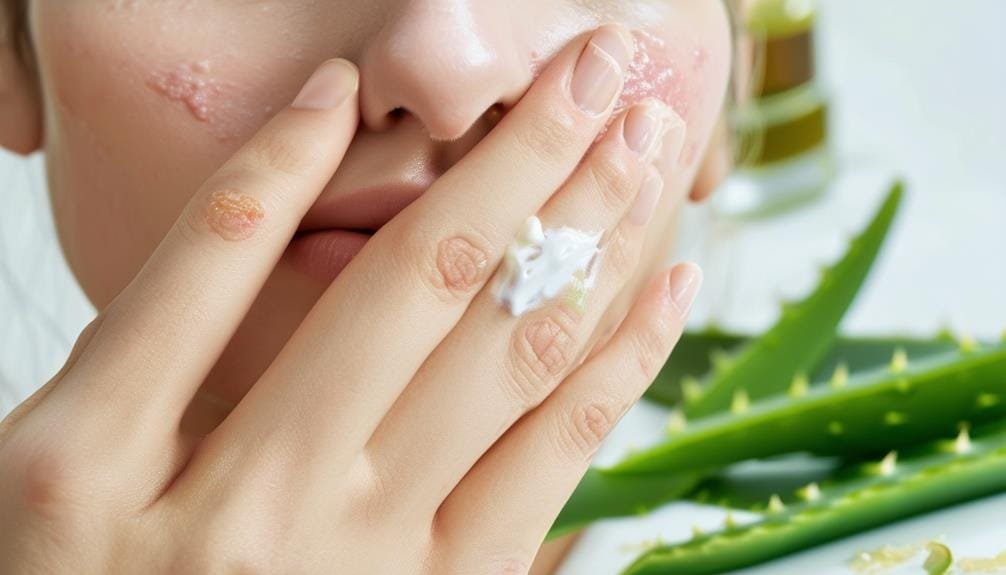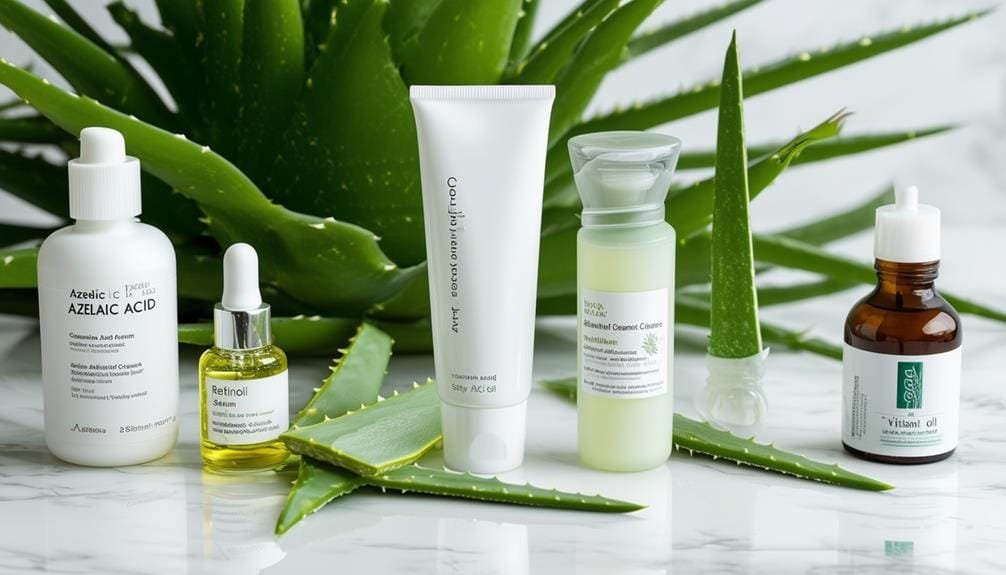You can effectively heal acne scars with azelaic acid cream treatment, which promotes cellular renewal and reduces post-inflammatory hyperpigmentation. Azelaic acid’s anti-inflammatory and antibacterial properties also prevent future breakouts. By regulating sebum production and unclogging pores, it creates an environment conducive to healing. With consistent application, you can expect improvements in skin texture and tone. As you explore the benefits and usage guidelines of azelaic acid cream, you’ll discover how to maximize its effectiveness and address specific skin concerns, leading to a clearer, more radiant complexion. Further understanding of its properties and applications will reveal its full potential.
Key Takeaway
- Azelaic acid cream treatment promotes cellular renewal and fades post-inflammatory hyperpigmentation (PIH) to heal acne scars.
- Azelaic acid’s anti-inflammatory properties calm redness and irritation, making it suitable for sensitive skin.
- Consistent application of azelaic acid cream accelerates the healing process of blemishes and reduces acne scars over time.
- Azelaic acid cream regulates sebum production, prevents future breakouts, and enhances overall skin health.
What Is Azelaic Acid Treatment
When you consider azelaic acid treatment for acne scars, you’re fundamentally leveraging a naturally occurring compound that promotes cellular renewal and exhibits multifaceted benefits for your skin. Azelaic acid is a compound found in grains like barley, wheat, and rye. In treating acne and acne scars, it’s commonly used in concentrations of 15%-20%. By promoting cellular turnover, azelaic acid cream works to fade post-inflammatory hyperpigmentation (PIH), reducing the appearance of acne scars over time.
You’ll also find that azelaic acid’s anti-inflammatory properties can help calm redness and irritation associated with acne and rosacea, making it suitable for sensitive skin types. In addition, its ability to inhibit melanin production aids in achieving an even skin tone and minimizing dark spots left behind by previous breakouts. As you apply azelaic acid cream, you’re not only addressing existing acne scars but also preventing future breakouts by regulating sebum production and unclogging pores.
Benefits of Azelaic Acid Cream
Azelaic Acid Cream offers a multifaceted approach to addressing acne scars, encompassing a range of benefits that enhance skin health and appearance. By using Azelaic Acid Cream, you can effectively reduce post-inflammatory hyperpigmentation (PIH) as it inhibits melanin production, resulting in an evened-out skin tone and minimized dark spots caused by acne scars.
| Benefits | Effects on Acne Scars | Skin Health Implications |
|---|---|---|
| Reduces PIH | Minimizes dark spots, evens skin tone | Improved appearance, reduced scarring visibility |
| Promotes cellular turnover | Facilitates faster healing of acne scars | Enhanced skin texture, reduced acne scar depth |
| Anti-inflammatory properties | Reduces redness and irritation | Soothed, calmer complexion |
| Suitable for sensitive skin | Reduced risk of irritation | Safe option for scar healing, inclusive for sensitive skin types |
Regular use of Azelaic Acid Cream will not only address existing acne scars but also help prevent future breakouts by regulating sebum production. This means you’re tackling both active acne and scars simultaneously, optimizing your skincare routine for better overall skin health. With its anti-inflammatory properties, Azelaic Acid Cream soothes and calms the skin, reducing redness and irritation associated with acne scars. As a result, your skin tone becomes more even, and your complexion looks healthier and more radiant. By incorporating Azelaic Acid Cream into your skincare regimen, you’re taking a proactive approach to healing acne scars and enhancing your skin’s overall well-being.
How Azelaic Acid Works

The key to azelaic acid‘s efficacy in treating acne scars lies in its multifaceted mechanism of action, which involves promoting cellular turnover, inhibiting melanin production, and regulating sebum production, all of which work in tandem to tackle the underlying causes of scarring. As you apply azelaic acid cream to your skin, it encourages cell turnover, promoting the healing of acne scars by facilitating the shedding of dead skin cells and stimulating the growth of new skin. This process helps to even out your skin tone and texture, reducing the appearance of acne scars.
Azelaic acid also inhibits melanin production, which helps to reduce post-inflammatory hyperpigmentation (PIH) and even out skin tone in areas affected by acne scars. Additionally, the acid possesses anti-inflammatory properties, which can diminish redness and irritation associated with acne scars, leading to a more uniform appearance. By regulating sebum production, azelaic acid prevents future breakouts and thereby reduces the likelihood of new scars forming from active acne. With its well-tolerated nature, azelaic acid is a suitable option for individuals looking to treat acne scars safely. As you continue to use azelaic acid cream, you can expect to see improvements in cell turnover, leading to even skin and a reduction in the appearance of acne scars.
Acne Scars and Azelaic Acid
As you consider azelaic acid’s benefits for treating acne scars, its effects on post-inflammatory hyperpigmentation and cellular turnover become significant factors in understanding how this ingredient specifically addresses scarring. Azelaic acid effectively diminishes post-inflammatory hyperpigmentation (PIH) by inhibiting melanin production, resulting in a more even skin tone and reduced appearance of acne scars. It also promotes cellular turnover, which aids in the healing process of acne scars, allowing for quicker skin regeneration and minimizing scar severity.
Here are 3 key ways azelaic acid targets acne scars:
- Reduces hyperpigmentation: Azelaic acid inhibits melanin production, resulting in a more even skin tone and reduced appearance of acne scars.
- Promotes cellular turnover: Azelaic acid aids in the healing process of acne scars, allowing for quicker skin regeneration and minimizing scar severity.
- Regulates sebum production: Regular use of azelaic acid can regulate sebum production, preventing future breakouts that could lead to new scarring.
Azelaic acid is well-tolerated by most skin types, including sensitive skin, making it a safe option for treating acne scars. Its anti-inflammatory properties also help to reduce redness and inflammation associated with acne scars, making them less visible. By understanding how azelaic acid targets acne scars, you can harness its benefits to effectively treat and manage scarring, ultimately achieving a smoother and more even complexion.
Reducing Redness and Inflammation

As you start using azelaic acid cream to tackle acne scars, you’ll likely notice its potent anti-inflammatory effects kicking in, calming inflamed skin and soothing redness almost instantaneously. With consistent application, you can expect significant improvements in skin redness and irritation, as seen in 70%-80% of individuals in clinical studies. By regulating sebum production and encouraging cellular turnover, azelaic acid helps minimize the associated redness and discomfort of acne-prone skin, often within just a few days of starting treatment.
Calming Inflamed Skin
Reducing redness and inflammation is a crucial step in addressing acne scars, and azelaic acid plays a key role in calming inflamed skin with its potent anti-inflammatory properties. When you apply azelaic acid cream to your skin, you’ll notice a significant decrease in redness and swelling, making it an effective treatment for acne scars.
3 Key Benefits of Azelaic Acid for Calming Inflamed Skin:
- Anti-inflammatory effects: Azelaic acid reduces redness and swelling by suppressing the production of pro-inflammatory chemicals in the skin.
- Improved skin tone: Regular application of azelaic acid cream can lead to a decrease in post-inflammatory hyperpigmentation (PIH), resulting in an even skin tone.
- Soothing sensitive skin: Azelaic acid is well-tolerated by sensitive skin types, making it an ideal treatment option for those prone to irritation while addressing redness and inflammation.
Soothing Redness Instaneously
Applying azelaic acid cream to your skin can instantly kick-start the process of calming red, inflamed areas associated with acne and rosacea, thanks to its powerful anti-inflammatory effects. You’ll experience significant relief from redness and irritation as the azelaic acid works to inhibit the production of inflammatory mediators, effectively calming the skin and minimizing the appearance of red bumps and pimples.
Clinical studies have shown that regular use of azelaic acid can lead to a 70%-80% improvement in skin redness and overall comfort within weeks of application. You can achieve consistent results by applying azelaic acid cream twice daily, which helps maintain its soothing effects over time. Many users report noticeable improvements in skin tone and a reduction in redness shortly after beginning treatment, showcasing its efficacy as a soothing agent for irritated skin. As a treatment, azelaic acid provides rapid and sustained relief from redness, making it an ideal solution for individuals seeking to alleviate the discomfort associated with acne and rosacea. By incorporating azelaic acid into your skincare routine, you can enjoy the benefits of a more even-toned and less inflamed complexion.
Fading Dark Spots and Blemishes
Azelaic acid targets post-inflammatory hyperpigmentation and dark spots by inhibiting melanin production, helping to even out your skin tone and reduce the visibility of acne-related blemishes. By using azelaic acid cream treatment, you can accelerate the healing process of blemishes and reduce the severity of acne scars over time. The cream promotes cellular turnover, which helps to fade dark spots and improve skin texture, leading to a more uniform complexion.
Here are three key benefits of using azelaic acid cream treatment to fade dark spots and blemishes:
- Inhibits melanin production: Azelaic acid effectively reduces the production of melanin, the pigment responsible for dark spots and hyperpigmentation, helping to even out your skin tone.
- Promotes cellular turnover: Azelaic acid accelerates the healing process of blemishes by promoting cellular turnover, which helps to reduce the severity of acne scars over time.
- Antibacterial properties: Azelaic acid has antibacterial properties that help prevent future breakouts, making it an effective treatment for acne-prone skin.
Regular use of azelaic acid cream treatment can markedly improve the appearance of dark spots and blemishes. Its gentle and non-irritating formula makes it suitable for sensitive skin types. By incorporating azelaic acid into your skincare routine, you can promote a more even-toned and radiant complexion. Remember to apply the cream consistently and patiently, as fading dark spots and blemishes takes time. With azelaic acid, you can achieve a smoother, brighter complexion and say goodbye to acne scars.
Preventing Future Breakouts

As you continue using azelaic acid cream to treat acne scars, you can also take steps to prevent future breakouts. By combining azelaic acid with other breakout prevention methods, such as maintaining a consistent skincare routine and using natural remedies, you can reduce your risk of new breakouts. Now, let’s explore some effective ways to prevent future breakouts and maintain healthy, acne-free skin.
Breakout Prevention Methods
Several key strategies can help you prevent future breakouts and maintain clear skin while using azelaic acid cream to treat acne scars. To achieve this, it’s important to adopt a thorough skincare routine that incorporates gentle exfoliation, reduces the buildup of dead skin cells, and regulates sebum production.
Here are three vital steps to prevent future breakouts:
- Cleanse your skin regularly: Use a gentle, non-comedogenic cleanser to remove excess oil and dead skin cells, reducing the likelihood of clogged pores and breakouts.
- Incorporate topical treatments: Azelaic acid cream can help reduce inflammation and regulate sebum production, greatly decreasing the likelihood of future acne outbreaks.
- Maintain a balanced diet: Eat a diet rich in antioxidants and omega-3 fatty acids to support skin health and prevent hormonal fluctuations that can trigger breakouts.
Natural Breakout Remedies
To further minimize the risk of future breakouts, you can incorporate natural remedies into your skincare routine that target the root causes of acne, such as inflammation, bacterial overgrowth, and hormonal imbalances. Regularly cleansing your skin with non-comedogenic products helps prevent the buildup of oil and dead skin cells, reducing the risk of future breakouts. Additionally, ingredients like salicylic acid and benzoyl peroxide can effectively target acne-causing bacteria and unclog pores.
Maintaining a balanced diet rich in fruits, vegetables, and omega-3 fatty acids supports skin health and may help minimize hormonal fluctuations that trigger breakouts. It’s also essential to avoid touching your face with dirty hands and minimize the use of heavy makeup to reduce the likelihood of developing acne. Consistent use of azelaic acid not only helps heal existing acne scars but also regulates sebum production, thereby preventing future breakouts. By incorporating these natural remedies into your skincare routine, you can effectively prevent future breakouts and maintain healthy, clear skin. By taking a proactive approach to your skin health, you can reduce the risk of acne and enjoy a radiant, glowing complexion.
Suitable Skin Types and Conditions
Anyone considering azelaic acid cream for acne scars can benefit from its gentle formulation, which makes it suitable for all skin types, including sensitive skin. As you explore the benefits of azelaic acid, you’ll find it’s particularly beneficial for individuals with rosacea, as it helps reduce redness and inflammation associated with this condition. The cream is also effective in addressing post-inflammatory hyperpigmentation (PIH), making it ideal for those with darker skin tones who experience discoloration from acne scars.
Here are 3 key benefits of using azelaic acid cream:
- Effective in treating oily and acne-prone skin: Azelaic acid regulates sebum production, preventing future breakouts while healing existing scars.
- Safe for sensitive skin: Clinical studies indicate that azelaic acid is well-tolerated across various skin types, with a low incidence of adverse effects.
- Beneficial for darker skin tones: Azelaic acid effectively addresses post-inflammatory hyperpigmentation (PIH), a common concern for individuals with darker skin tones.
Whether you have sensitive skin, acne-prone skin, or concerns about hyperpigmentation, azelaic acid cream offers a safe and effective solution. Its low incidence of adverse effects and gentle formulation make it an excellent choice for those seeking a reliable treatment for acne scars. By choosing azelaic acid cream, you’re selecting a treatment that’s tailored to your skin’s needs, helping you achieve a smoother, more even complexion.
Using Azelaic Acid Cream Effectively

As you start using Azelaic Acid Cream for acne scars, you’ll want to apply it effectively to maximize its benefits. To do this, you’ll need to understand how to incorporate the cream into your skincare routine, potential side effects to watch out for, and the advantages of consistent application. By applying Azelaic Acid Cream correctly and being aware of its effects, you can achieve ideal results in reducing the appearance of acne scars.
Benefits of Azelaic Acid
Azelaic Acid Cream’s multifaceted benefits make it an effective treatment for acne scars, promoting skin renewal and reducing the appearance of post-inflammatory hyperpigmentation. By using Azelaic Acid Cream, you can reap several benefits that contribute to healthy skin. Here are three key advantages:
- Reduced acne severity: Azelaic Acid Cream promotes cellular turnover, which helps to heal acne scars and reduce their severity over time.
- Diminished dark spots: The cream inhibits melanin production, diminishing post-inflammatory hyperpigmentation (PIH) and evening out skin tone.
- Soothed skin: Azelaic Acid Cream’s anti-inflammatory properties minimize redness and irritation associated with acne scars, contributing to a smoother complexion.
As you incorporate Azelaic Acid Cream into your skincare routine, you’ll notice improvements in skin texture and tone. Regular use can regulate sebum production, preventing future breakouts and further scarring. With its multifaceted benefits, Azelaic Acid Cream is an excellent solution for reducing acne scars and promoting healthy skin. By choosing Azelaic Acid Cream, you’re taking the first step towards achieving a smoother, more even complexion. With consistent use, you’ll be on your way to reducing dark spots and enjoying healthier, more radiant skin.
Applying Azelaic Acid Cream
To maximize the benefits of azelaic acid cream and minimize potential irritation, you should follow a specific application regimen. Apply azelaic acid cream once daily, preferably at night, to allow your skin to acclimate and minimize potential irritation. Start with a lower concentration of 15% if you have sensitive skin, and gradually increase to 20% as your skin becomes accustomed to the treatment.
| Application Guidelines | Recommendations | Precautions |
|---|---|---|
| Frequency | Apply once daily, preferably at night | Avoid applying during the day |
| Concentration | Start with 15% for sensitive skin, increase to 20% as needed | Be cautious when increasing concentration |
| Amount | Use a pea-sized amount, spreading evenly over affected areas | Avoid contact with sensitive areas like eyes and mouth |
After applying azelaic acid cream, incorporate a gentle moisturizer to combat dryness and maintain skin hydration. Consistent application is key, as users typically notice improvements in acne scars and skin clarity within three weeks of regular use. By following these guidelines, you’ll be able to effectively apply azelaic acid cream and unleash its full potential in treating acne scars.
Azelaic Acid Side Effects
While consistent application of azelaic acid cream is key to achieving ideal results, it’s equally important to be aware of the potential side effects that may arise during treatment. As you use azelaic acid cream, your skin may experience some sensitivity and irritation, especially during the initial stages. You may notice burning, tingling, peeling, dryness, or redness, but these effects typically subside as your skin becomes more tolerant.
To guarantee your safety and comfort while using azelaic acid cream, take note of these potential concerns:
3 Important Considerations
- Skin Sensitivity: Your skin may become more sensitive to the sun, so be sure to apply sunscreen daily to protect it from UV exposure.
- Irritation: Avoid using astringents or deep-cleansing products, as they can exacerbate dryness and irritation.
- Less Common Side Effects: Although rare, watch out for blistering, joint pain, hives, fever, or difficulty breathing, and seek medical attention immediately if you experience any of these symptoms.
Start with a lower concentration of azelaic acid (around 15%) and gradually increase as your skin becomes more tolerant. Always prioritize your skin’s health and safety.
Potential Side Effects and Risks
When using azelaic acid cream to treat acne scars, you may experience several common side effects as your skin adjusts to the treatment. It’s vital to be aware of these potential side effects to guarantee the safe and effective use of azelaic acid. The most common side effects include burning, stinging, dryness, and peeling, which may be more pronounced if you have sensitive skin. To minimize these effects, treat your skin with a gentle touch, avoiding harsh products that can strip your skin of its natural oils.
While rare, more serious side effects can occur, and it’s important to be aware of them. If you experience blistering, joint pain, hives, fever, or difficulty breathing, seek medical attention immediately. These reactions can be a sign of an allergic reaction or a more severe underlying condition. To secure the safety of azelaic acid, use it cautiously, especially if you have a history of skin conditions or allergies.
To reduce the risk of irritation and dryness, avoid combining azelaic acid with astringents or deep-cleansing cleansers. Additionally, apply sunscreen daily to protect your skin from increased sensitivity to the sun. By understanding the potential side effects and taking steps to mitigate them, you can safely harness the benefits of azelaic acid cream to treat acne scars and achieve a smoother, healthier complexion. Always prioritize the safety of azelaic acid and take a gentle approach when treating your skin.
Combining With Other Skincare Products

Azelaic acid cream can be paired with other skincare products to enhance its therapeutic effects, but it’s crucial to choose combinations that complement its properties and minimize potential irritation. When combining azelaic acid with other products, you’ll want to maximize efficacy and safety in the treatment of acne.
Here are three key combinations to evaluate:
- Azelaic acid and topical retinoids: This combination enhances skin texture, combats acne, and promotes scar healing through increased cell turnover.
- Azelaic acid and Vitamin C: This pairing improves skin hydration and promotes an even skin tone, addressing hyperpigmentation.
- Azelaic acid and gentle moisturizers: This combination helps maintain skin hydration while minimizing irritation, ensuring you can tolerate the azelaic acid gel without discomfort.
When introducing azelaic acid into your routine, especially with potent actives, do so gradually to minimize irritation and allow your skin to acclimate. Avoid using astringents or deep-cleansing products, as these can undermine the benefits of azelaic acid treatment. Always apply sunscreen during the day, especially when combining azelaic acid with other active ingredients, to protect sensitive skin from UV damage and enhance overall treatment effectiveness. By carefully selecting complementary products and following a thoughtful skincare routine, you can optimize the benefits of azelaic acid cream in the treatment of acne and acne scars.
Frequently Asked Questions
Does Azelaic Acid Work for Acne Scars?
You’re staring at the mirror, scrutinizing those pesky acne scars. You wonder, “does azelaic acid work for acne scars?” Yes, it does! With its benefits of promoting cellular turnover and inhibiting melanin production, azelaic acid is a proven treatment for acne scars. As you apply the cream, be gentle to minimize skin sensitivity. Master the application techniques, and you’ll be on your way to smoother, more even-toned skin. Azelaic acid cream benefits also include reducing inflammation and unclogging pores, making it an effective option for those with acne-prone skin. As you continue to use the cream, be patient and consistent in your application, as it may take a few weeks to see noticeable results. With regular use, you’ll soon be able to bid farewell to those stubborn acne scars and welcome healthier, clearer skin.
How Long Does Azelaic Acid Take to Work on Scars?
You’ll likely start seeing improvements in acne scars within 4 to 12 weeks of using azelaic acid, depending on your skin type and application frequency. If you have sensitive skin, you may want to begin with a lower concentration and gradually increase as your skin becomes more tolerant. Combination products may also enhance expected results. Be patient, as consistent use will lead to noticeable improvements in skin texture and reduced scar visibility over time.
How Quickly Does Azelaic Acid Work on Acne?
You’re probably excited to ‘hit the ground running’ and see results from using azelaic acid on your acne. Generally, you can start noticing improvements in your skin within a few days to a few weeks of consistent use. Azelaic acid benefits, including reduced inflammation and redness, become apparent quickly. By mastering application techniques and being aware of skin tolerance levels, you can access effective acne treatment alternatives and achieve healthier-looking skin.
Can I Use Azelaic Acid as Spot Treatment?
You can use azelaic acid as a spot treatment for acne scars. Its ability to promote cellular turnover and reduce post-inflammatory hyperpigmentation makes it effective in fading dark spots. You’ll apply a thin layer directly to the affected area, typically twice a day. Since it’s generally safe for sensitive skin types, you don’t have to worry about excessive irritation. Be patient, as improvements will be noticeable over time with consistent application.





